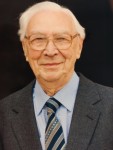Commander Aubrey John Russell Pegler RN OBE, G3ENI, 12 September 2015
Commander A J R Pegler RN OBE, G3ENI (RNARS 23) became a silent key on 12th September 2015 at the grand age of 95. It is an honour and privilege to give this tribute to John. He joined the Navy as a cadet at the age of 17. During the war he was on the Arctic convoys and was decorated 3 times by the Russian government. It was recently that his involvement with Arctic convoys was supplemented by the Russian government in the form of the Ushakov Arctic Convoy Medal.
During his early years he built his first radio at the age of 11.
It was whilst he was at Lee on Solent in 1960 that John thought it would be a good idea to have a Royal Naval Amateur Radio Society. He helped to set it up with like-minded people such as Lt John Riggs RN, G3AWO, Mike Matthews, G3JFF and George Tagg, G8IX. At the meeting at HMS Mercury 26 members attended and the Society was born. John was chairman of the RNARS for 8 years, from 1962 – 1968.
John was a member of the Royal Naval Officers Association, the HMS Ajax Veterans Association, the River Plate Veterans Association and a very long standing member of the RSGB (listed as 76 years in the February 2015 Honour Roll).
As a scientific engineer he was involved with the instrumentation of the Avenger, Hellcat and Corsair aircraft in 1943. In 1947 he was responsible for sorting out the teething problems with the then-new Sea Fury fighter bomber. After serving in HMS Eagle John did a post graduate work study course and in 1956 became production manager to inspect, repair and modify Gannet anti-submarine aircraft fitted with the Double Mamba engine.
In 1957 the Cold War was on and the Sputnik satellite was launched by the Russians. John was one of the first people to have heard the signals pulsing on his receiver.
During 1961 – 1963 John worked on the medium range anti-submarine torpedo carrying helicopter for operations, landing on the sterns of the new Leander class frigates. In fact he has a patent on a landing gripping arrangement on the platforms. It was during this procedure that the wheels of his mini car were used in the research. The final helicopter version was the Wasp.
At the end of 4 years in the Admiralty he worked on the re-development of accommodation, training facilities and aircraft workshops. Following this he received his well-deserved OBE on 1st January 1970.
After retirement John became a retired officer for the re-development of Portsmouth, Devonport, Chatham and Portland Naval bases for a new class of frigates, destroyers, submarines, aircraft carriers and mine sweepers. He also dealt with the new test facility for the next generation of nuclear engines known as PWRS at Dounreay in Scotland.
On the air John was always good company, encouraging and full of technical advice to those who would ask for it. He was a fount of information about any subject that was being talked about and treated everyone as an equal, irrespective of their level of knowledge in the field of amateur radio.
He was always eager to help anyone and he designed and helped to build a speech aid using an oscilloscope which enabled severely deaf children to copy sounds. This was in use for many years in a Unit for Hearing Impaired children. In those days there were no devices like that. He was also helpful in setting up a radio station in the same school which was funded by the late King Hussein of Jordan. It was used for many years and the then radio club had lots of members.
Regretfully his beloved wife Jean died in 2009. They had three children, 4 grandchildren and 7 great- grandchildren. He was happily married to Jean for 65 years.
He threw himself into the RSGB’s 5MHz experiment with much enthusiasm and was a regular follower of the Sunday RSGB GB2RS 5 MHz News and contributor to its corresponding net. He was also a founder member of the ‘Sunset’ net later the same day, which analysed propagation changes on the band at said time.
John wrote several articles about aerials and even experimented in the use of trees as aerials. He was interested in the reflectivity of soil types and measured the conductivity of soil under various conditions. His interest in stochastic noise and the way it affected weak signals resulted in finding that the weak signals ‘surf’ the noise level allowing it to be more readable. Without stochastic noise a weak signal was lost or difficult to read. Many of these items appeared as articles in the quarterly online publication The 5MHz Newsletter, to which he was a regular contributor together with his long-time colleague Danny Sharpe, G3ZUN (and prior to that in the ‘Technical Topics’ pages in RadCom).
With such an enquiring mind his engineering and scientific approach has been of benefit to many people. We have to thank him for being a founder member of the Royal Naval Amateur Radio Society and long-standing member of the Radio Society of Great Britain.
Tribute by Danny Sharpe, G3ZUN (RNARS 459)
and Paul Gaskell, G4MWO (Editor, The 5MHz Newsletter, and GB2RS 5MHz Newsreader)
Category: Silent Keys











